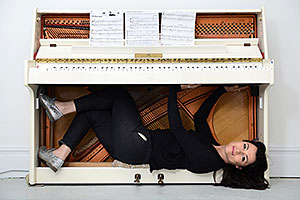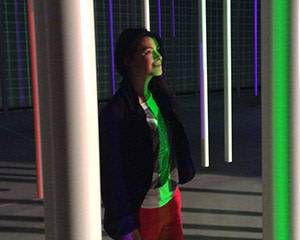Es Devlin’s designs for (cultural) life

Roula Khalaf, Editor of the FT, selects her favourite stories in this weekly newsletter.
Think of some of the most striking visual moments that have pepped up British culture over the past decade: of Damien Hirst’s giant “spin-painted” Union Jack that closed the London Olympic Games; of the depraved art deco setting of David McVicar’s production of Salome at the Royal Opera House; of the giant flying hot dog ridden so enthusiastically by Miley Cyrus on the London leg of her world tour this month.
That they should grace the stages of one city is splendid enough; that they should all spring from the drawing board of the same designer is little short of extraordinary. The name of Es Devlin may still be relatively unrecognised – even among keen patrons of the performing arts – but is there any single figure that better encapsulates London’s voracious and eclectic cultural habitat?
Devlin’s creations are bold, erudite and unafraid to flirt with kitsch. She does irony, and she gets it when things need to be more serious. She makes connections where there only seems to be scope for catastrophic cultural misunderstandings. Last year she collaborated with director Lyndsey Turner on Lucy Kirkwood’s prize-winning Chimerica at the Almeida Theatre. “She is an extraordinary collaborator,” Devlin says of Turner, adding matter-of-factly, “I met her through [the pop singer] Mika.”
To chart the progress of a hard-edged political play on US-Chinese relations from the promptings of a Beirut-born pop singer would make a fascinating flow diagram, which would surely need to place Devlin close to its core. She puts it more organically: “I am like a little parasite that gets thrown between the two extremes of the cultural world that would otherwise never meet.”
We meet for a quick bite near her new home in Dulwich, at a café full of squadrons of mothers with their newborns. Devlin herself, a mother of two, is between sports days, and has a mums’ race in the afternoon to occupy her attentions. “Strictly non-competitive,” she assures me, and switches swiftly to higher matters before I get the chance to ask her what that even means.
She is putting finishing touches to Connectome, Alastair Marriott’s new dance for the Royal Ballet, which opens on Saturday night as part of a new triple bill at Covent Garden. She gives me the briefest of explanations of the science behind the work, which involves the mapping of neural connections in the brain. “It involves multiple lives’ work,” she says. “To map the connections of a millipede has just taken 10 years.”

The Royal Opera House works on stricter timescales. Her design for the new work has, as always, been governed by the marriage of vision and pragmatism. “One can choose any language to talk about these things,” she says. “We were able to choose anything that we could afford 375 of. So they turned out to be three-and-a-half-metre-long white scaffolding poles.” They will be pre-programmed to move as if of their own violation.
It is Devlin’s first ballet at the opera house, although she knows the place through her work with opera. I say that the stagecraft and technological innovations in both art forms have advanced exponentially in recent years. “A couple of things have happened,” she replies. “Affordable projectors suddenly became bright enough to use. And then newer and faster systems, and more people trained to use them. There used to be one. Now there are four.”
Added to which, there has been a change in sensibility, led by her generation (Devlin is 42). “When I was a student I was intoxicated by the work of Robert Lepage, Robert Wilson, Pina Bausch. That was the work we absorbed and aspired to. And now we have come through our 10 years of 10,000 hours, we are the next step.” And did the Royal Opera House prove ready for that evolution? “Fantastically so. It is a Rolls-Royce machine.”
Evenings at the ballet, thanks to the work of Marriott, Wayne McGregor and Liam Scarlett, were where the “world’s tastemakers” got together, she says. “McGregor has added another dimension to the whole affair. And just being in a room with [the dancers] – you feel you are with superior beings!”
I ask her about her still relatively unusual springing back and forth from popular to high cultural forms. “Everything that’s alive in my work I attribute to those cross-fertilisations,” she says emphatically. “It is like cooking with unexpected combinations of ingredients. It is catching your own logic by surprise.”
It is long overdue, I suggest. “But I still take a lot of flak for it,” she says. “One of my recent collaborators had a real go at me for doing the Miley thing [Bangerz, the singer’s world tour]. It was an absolute judgment: how could I demean myself like that?” An exasperated shrug. “Ultimately what we are talking about is snobbery.”
She goes on: “And then I look at audiences. I make a piece in Dresden, for example. I get very involved with it. I miss my children’s open days at school. I give my lifeblood to it. And then there are eight performances of it, the good burghers of Dresden, maybe 1,200 a night, come to see it. And then it’s shelved. If I do a Kanye West concert, that’s a world tour, all around the globe, that attracts 20,000 people a night. That’s very important to me.”
She raves briefly about Ivo van Hove’s Young Vic production of A View from the Bridge, which she has just seen. “I looked at the audience and I knew most of them. Look, I love working in the theatre. I wouldn’t be without either.”
It was thanks to her work on the Take That tour in 2010 that Devlin was asked to participate in the biggest gig of her career: designing the Olympics closing ceremony. How was that? I ask. What was her brief like? “Terrible brief,” she says disconsolately, discarding the use of verbs. “Desperate brief. A flag. A Union Jack flag. What are you going to do? I really struggled.”
She took to academic research of the subject, studying the various designs of the amalgamated flags of England and Scotland commissioned by James I before the union of the two countries in 1603. But the use of the flag that “really set my imagination going” was that of the Sex Pistols. “They tore it all up. I needed that honesty and energy but it had to be not destructive. I thought about it and the answer was Damien. He made it explode like a firework. We mixed it all up and spat it out.”
I make a vaguely sarcastic remark about some of the other artists who appeared in the ceremony. “Not enough people wanted to do it,” she says. “By February, we only had Elbow, Eric Idle and Elgar’s estate. Everyone else said no. Of course once they saw the opening ceremony, they all wanted to do it.”
Things have come a long way, I say, since the Spinal Tap days of spectacle hubris. “I was reading a book on the development of modern Brazil,” she says with a gleeful lateral leap, “and it talked about the clash between making a choice for the possible, which leads to atrophy, and making a choice for the impossible, which becomes a tragic failure. I thought that was like set design.”
Is there a middle way? “You can’t know if something is going to work. You can never know. But you can have a hunch.”
‘Connectome’, Royal Opera House, London, until June 13, esdevlin.com
Comments